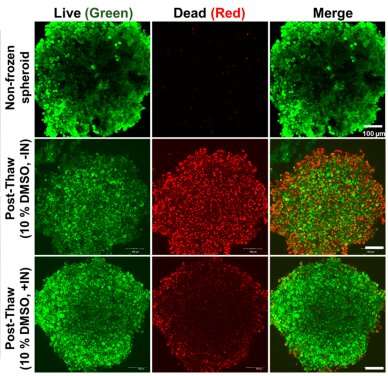This article has been reviewed according to Science X's editorial process and policies. Editors have highlighted the following attributes while ensuring the content's credibility:
fact-checked
trusted source
proofread
Cool as ice: How new research is helping scientists preserve cells

A method to store advanced cell models has been developed by researchers at the University of Warwick.
The technology, which was shared in the journal JACS Au, could improve the cryopreservation of cells, tissue culture and 3D cells models used variety of applications, including research, medical therapies and agriculture.
Cryopreservation is the process of freezing cells at very low temperatures to preserve them for later use. However, when cells are frozen, ice can form inside the cells, which can damage or kill them. This is a particular problem for 2D and 3D cellular models, which replicate some of the properties of organs and have complex structures that make it difficult for cryoprotectants to reach all their constituent cells.
The new method developed by the researchers at the University of Warwick uses soluble ice nucleating polysaccharides (a type of molecule that interacts with ice) produced by tree pollens to ensure ice forms outside of cells. This helps prevent the formation of damaging ice in cell interiors. The method was tested on a variety of 2D and 3D tissue models and was found to be effective in reducing intracellular ice formation and improving cell viability.
The work has particular importance because of a recent decision by the U.S. Food and Drug Administration, removing the requirement to test new drugs on animals and expanding the need for methods for storing and transporting organ-like cell models.
Dr. Thomas Whale, Department of Chemistry at the University of Warwick, said, "Cryopreservation is essential across all biomedical research and drug discovery. Most people assume cryopreservation is focused on stopping ice forming, but it is actually essential to help ice form, at the highest temperature possible. We achieved this, and show that by helping the ice form we can dramatically improve the recovery of these cells."
Professor Matthew Gibson, Department of Chemistry, University of Warwick, added, "This innovative work has been inspired by nature, which has evolved elegant solutions to control exactly when, and where ice forms. Our discovery shows that we can store complex cell models in a freezer, so they are 'ready to use,' to advance basic biomedical research. Another advance is that wider available of complex cell models may reduce the need for animal testing in the drug development process."
More information: Kathryn A. Murray et al, Chemically Induced Extracellular Ice Nucleation Reduces Intracellular Ice Formation Enabling 2D and 3D Cellular Cryopreservation, JACS Au (2023). DOI: 10.1021/jacsau.3c00056
Provided by University of Warwick





















